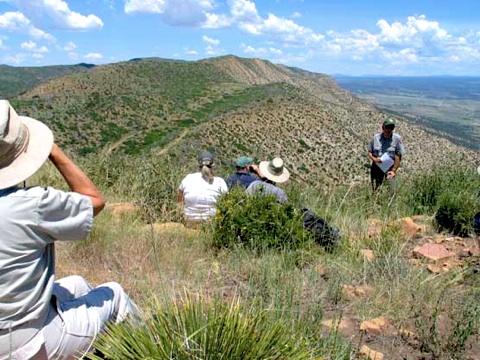Editor's note: The following story on wilderness at Mesa Verde National Park was written by Nate Thompson, who is working in the park's "Teacher-Ranger-Teacher" program.
Forty-five years after the first wilderness areas were designated in the United States, the Mesa Verde Wilderness area remains largely unknown to the public, even though most people in Cortez can see it every day.
Wilderness is a congressionally designated title for public land, giving it the highest level of government protection from certain activities, such as mechanized vehicle travel and drilling for oil and gas development.
Mesa Verde National Park recently celebrated wilderness, and the passage of the Wilderness Act of 1964. A small group of park employees and volunteers traveled to Mesa Verde’s eastern boarder – near the Mancos River Valley.
“I was pleasantly surprised to learn about Mesa Verde’s wilderness area,” Laurel Rematore, executive director of the Mesa Verde Museum Association and event participant. “I think it is a well kept secret more people should know about and appreciate.”
George San Miguel, the park’s supervisory natural resource manager, led the group and used the trip to educate them about the history of wilderness designation and specifically how the Mesa Verde Wilderness area was created.
“The park's original reaction to designating parts of Mesa Verde as a wilderness was one of hostility,” San Miguel told the group. “At the time, there was a lot of emphasis on development and catering mainly to automotive visitation.”
San Miguel explained that the original study of roadless areas – a qualification for wilderness – in park included over 42,000 of its 52,000 acres. The study resulted in most of that area being recommended for wilderness designation by some groups, he said. But the National Park Service countered that proposed acreage and said it wanted only 7,100 acres designated as wilderness at Mesa Verde.
Because the idea of wilderness was still a relatively new concept at the time, San Miguel said, public hearings held in Cortez about the issue were hotly debated by groups ranging from the local chambers of commerce to the Sierra Club. But now that the idea of wilderness has been around for 45 years, he added, “The concept of wilderness has been embraced.”
On the other hand, San Miguel explained, the national public was actually “ahead of the government” in wanting to give certain public lands the highest level of resource protection.
Since 1964, Congress has designated over 50 percent of the land in national parks as wilderness. At Mesa Verde, 8,500 acres of the park currently are designated as wilderness. This area is actually made up of three small, separate, sections of the north and east park boundaries and includes what most people view of the mesa from the nearby communities of Cortez and Mancos. San Miguel said the separations between the wilderness areas were left because of the existing road into the park and to provide utility access.
A number of new wilderness areas were created this year from other public lands and includes much of Rocky Mountain National Park. This and other new wilderness areas were recently created as part of the Omnibus Public Land Management Act of 2009. The law passed on March 30 created 52 new wilderness areas and added acreage to 26 existing areas – for a total addition of over 2 million acres of land to the National Wilderness Protection System.
“The Mesa Verde Wilderness is still the fifth smallest national park wilderness area in the nation,” San Miguel said, while viewing the park’s wilderness area from the Park Point overlook. “The Wrangell-Saint Elias Wilderness (in Alaska) is the largest with over 9 million acres … Grand Canyon National Park has zero wilderness areas. But it does have 1.1 million acres of proposed wilderness.”
Nate Thompson is currently working as the “Teacher-Ranger-Teacher” at Mesa Verde National Park and conducts kids programs at the historic Chapin Mesa Archeological Museum. He teaches journalism and science at Montezuma-Cortez High School.




Add comment